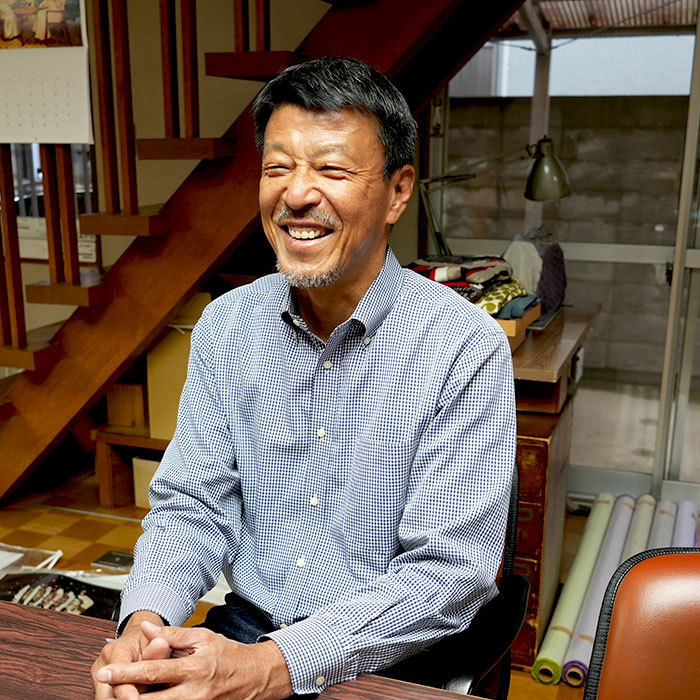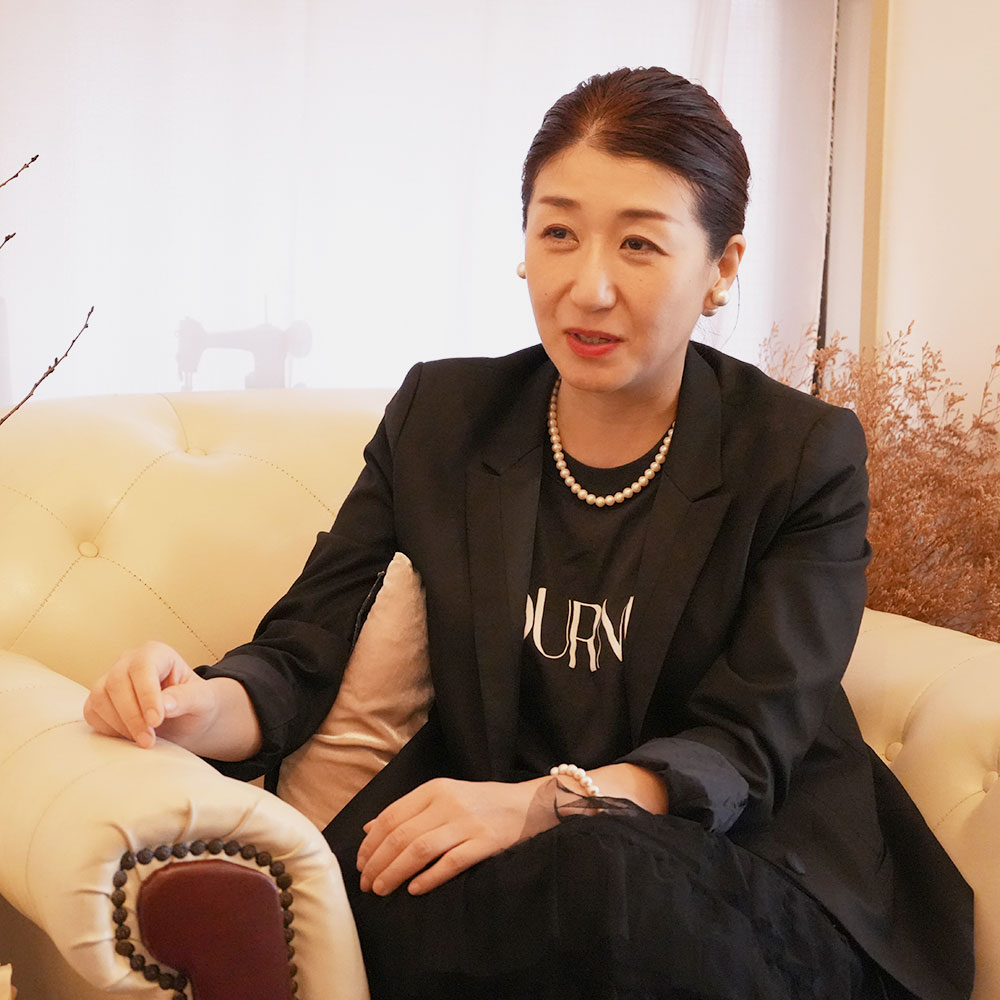Here’s the translation following your guidelines
- Textile industry
- Other manufacturing
- Unique Products & Services
- Japanese Traditional Technology
- Creative
Kyoto
Kyoto Yuzen is one of Japan's representative patterned dyeing techniques, widely recognized as a traditional craft around the world. Over time, dyeing techniques for garments have evolved, involving methods such as hand-brushing colors, embroidery, and embellishing with gold and silver powder or foil. The style known as Yuzen dyeing was perfected by Miyazaki Yūzensai during the Edo period.
The brand 'NOB MIYAKE,' produced by Miyake Crafts Co., LTD, located in Ukyo Ward, Kyoto, was founded by Nobumi Miyake, a traditional craftsman specializing in Kinsai (gold decoration) and Yuzen dyeing. Since establishing the predecessor of Miyake Crafts in 2014, Miyake has crafted over 10,000 traditional bridal garments in his career. He is a seasoned artisan who has also created costumes for numerous celebrities. His technique of adorning fabric with gold leaf, glitter, shells, and more, creating beautiful and dazzling effects, has received high acclaim both domestically and internationally.
In this article, we spoke with Nobumi Miyake, the CEO of Miyake Crafts Co., LTD, about how he first encountered Kinsai craft and his vision for the future.

PROTAGONIST
Nobumi MiyakeRepresentative director
Although he inherited his parents’ business, the collapse of the economic bubble led to a sharp decline in work.
Miyake’s parents were Kinsai artisans who created traditional kimono, such as houmongi and tomesode. To carry on the family business, he began training at a traditional bridal kimono workshop right after graduating from high school. After three years of training, he joined his parents’ workshop, and for a while, his days were filled with work. However, around 1990, the economic bubble burst, leading to a significant drop in their family business.
‘Work was decreasing day by day. Eventually, even my parents asked me to look for a side job. As I searched, I happened to find an opening at the bridal kimono workshop where I had originally trained. When I called, they told me to “come back immediately,” so I started working there part-time,’ Miyake recalled.
While working at this bridal kimono workshop, Miyake began to feel it suited him well. Bridal kimono are much more elaborate, with broader, more flexible designs than regular kimono.
‘I was convinced this was the right path for me. However, things didn’t go smoothly after that. Being young, I often struggled to fit in and had to move between workshops. But looking back, I see all of those experiences as invaluable,’ Miyake reflected.
Ultimately, his time at various workshops allowed him to hone his skills, and in 2014, he founded Miyake Crafts. Two years later, in 2016, the company was incorporated.
He handles 90% of the complex kimono production process.
The kimono-making process involves 20 to 30 steps, and in many workshops, each step is completely specialized. However, thanks to his years of experience, Miyake can handle over 90% of the process himself. This capability is a unique strength that sets NOB MIYAKE apart from others.
Before going independent, he relied on other craftsmen for about 70% of the work. But when he became independent, people left, and he could no longer depend on other craftsmen, forcing him to take on these tasks himself.
‘I truly struggled. Suddenly, I had to do everything that others had been handling. I was required to perform skills that usually take a lifetime to master, skills I had never done before. There was no way I could produce things at a marketable level,’ Miyake recalled.
Even when it comes to dyeing, the shade of red dyed by a craftsman is entirely different from that of a novice. The creation of colors is challenging, requiring a precise mix of dyes and adhesives. Additionally, the dyeing process itself is far from simple. However, driven by necessity, Miyake persevered through countless rounds of trial and error, mastering all the steps. It was through this journey that he developed the skills to handle 90% of the process on his own.


Kinsai is a traditional Japanese craft that involves applying gold or silver leaf, gold powder, and similar elements to dyed fabric, creating lavish decorations. However, most products nowadays have become industrialized, using machines with template stencils and silkscreen printing. In contrast, at NOB MIYAKE, no expenses are spent on stencils or plates; instead, they dedicate effort and time, using simple tools to hand-paint each piece.
‘Kinsai is the final step in fabric creation. Too much makes it overly extravagant, while too little feels sparse. Finding the right balance is difficult. Hand-painted details, with the attention they receive, allow us to create delicate, vivid patterns that are just right. Even with raden (a technique of decorating with shells), we soften the hard shells and carefully attach them by hand using unique methods,’ Miyake explained.
Miyake has always enjoyed and excelled at drawing and creating. When he entered the world of craftsmanship, he decided that if he was going to pursue this path, he wanted to become the best and set his sights on becoming a Living National Treasure.
Embracing Tradition and Innovation
At NOB MIYAKE, in addition to traditional Japanese bridal garments such as iro-uchikake and shiromuku, they have recently started selling T-shirts and accessories. Concerned about relying solely on kimono, Miyake decided to apply his Kinsai techniques to other products. However, while kimono production follows established processes, the same techniques can’t be directly applied to other items. He encountered challenges such as being unable to use traditional dyes and facing entirely different dyeing methods. Despite these difficulties, Miyake finds enjoyment in the creative process.
‘My motto is to make people wonder, “How on earth is this made?” I often get unusual requests, and the challenge of doing the seemingly impossible is what makes it interesting. For instance, I’ve been asked to make a gold-decorated T-shirt that can be washed in a washing machine. It’s by consistently doing what’s unconventional that I’ve developed skills others don’t have. So, I’m actually very grateful for customers who make such requests,’ Miyake said.
The founder of Yuzen dyeing, Miyazaki Yūzensai, was originally an artist who painted fans. He transformed the vibrant images he painted on paper into kimono dyeing, sparking a major revolution. This became what we now call ‘Yuzen dyeing.’ ‘That’s what I want to do,’ Miyake remarked, his eyes gleaming. Perhaps one day, the innovative work of the Kinsai workshop NOB MIYAKE will be recognized as a part of Japan’s traditional crafts.
Becoming a Living National Treasure is just a milestone.

During the economic bubble period 20 years ago, the kimono market was worth 1.8 trillion yen, but by 2023, it had dwindled to 224 billion yen, just one-eighth of its former size. On this subject, Miyake commented:
‘It’s sad, but that’s simply the flow of time. However, I believe that the kimono market will never disappear completely. Even if the skills and designs for making uchikake are adapted to create other products, I will never stop making uchikake. While the form may change with the times, the original essence must not be lost.’
Miyake Crafts Co., LTD always works with a global perspective. For example, they have supplied pieces to a certain royal family, exhibited collaborative works with Japanese artists at the Louvre Museum in Paris, showcased their art at the World Trade Center in Dubai, and even partnered with Warner Brothers to create DC Batman T-shirts.
What was once his goal—to become a Living National Treasure—has now become merely a means. It is part of the process of spreading Japanese craftsmanship. Miyake shared his vision for passing down traditional craft skills to future generations:
‘Over my 38 years, I’ve seen many artisans and workshops close down. I believe my role is to spread the techniques of Kinsai craftsmanship around the world. By showcasing the techniques and designs of kimono-making globally, I hope Japanese people will take pride in the incredible artisans we have here in Japan and the amazing traditional skills we possess.’
Lately, even at weddings, kimono have become a rare sight. Traditional Japanese crafts are something that should never be forgotten, especially by Japanese people. Without individuals dedicated to preserving these techniques, we risk losing these exceptional skills that Japan can proudly share with the world.
Japan’s creative potential is the greatest in the world.

In recent years, the rise of AI has brought concerns about certain professions potentially disappearing as AI takes over tasks. However, the work of craftsmen, grounded in handcraftsmanship, will never disappear. Still, it is true that passing down these skills is challenging, and the number of individuals taking up this work is declining. Miyake expressed his desire to establish a school dedicated to preserving Japan’s traditional techniques.
‘A school that encompasses Japanese traditional crafts, including design, culture, and technology. Currently, Japanese schools lack opportunities to foster creative talents. Because such schools haven’t existed until now, I believe that Japan’s potential for creativity is the greatest in the world. Therefore, I want to build a place where I can nurture that potential to the best of my ability,’ Miyake said.
Miyake continues to enjoy new challenges while preserving tradition. Even when his family business faced difficulties following the burst of the economic bubble, he relentlessly honed his skills to the point where he could complete most of the kimono-making process on his own.
Miyake’s goal is to connect Japanese craftsmanship to the future. His approach of embracing both tradition and innovation will surely inspire many artisans to find courage in their own work.
INFORMATION

Miyake Crafts Co., LTD
Layering. Hands gently overlapping, years accumulating. Feelings from parents to children conveyed over the passage of time.
And the kimono, with its layered collars. With thoughts of the couple stepping into a new chapter of life, we add layers of color to the fabric today as well.
Founded on the joy of being a part of your special day.
- Founded in
- 2014
- No. of employees
- 3
- Website
- https://nobmiyake.net/
- Writer:
- GOOD JOB STORY 編集部








